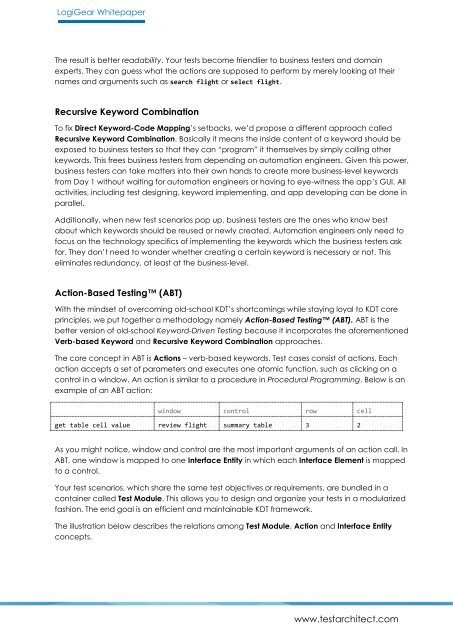The Evolution of Keyword Driven Testing
You also want an ePaper? Increase the reach of your titles
YUMPU automatically turns print PDFs into web optimized ePapers that Google loves.
LogiGear Whitepaper<br />
<strong>The</strong> result is better readability. Your tests become friendlier to business testers and domain<br />
experts. <strong>The</strong>y can guess what the actions are supposed to perform by merely looking at their<br />
names and arguments such as search flight or select flight.<br />
Recursive <strong>Keyword</strong> Combination<br />
To fix Direct <strong>Keyword</strong>-Code Mapping’s setbacks, we’d propose a different approach called<br />
Recursive <strong>Keyword</strong> Combination. Basically it means the inside content <strong>of</strong> a keyword should be<br />
exposed to business testers so that they can “program” it themselves by simply calling other<br />
keywords. This frees business testers from depending on automation engineers. Given this power,<br />
business testers can take matters into their own hands to create more business-level keywords<br />
from Day 1 without waiting for automation engineers or having to eye-witness the app’s GUI. All<br />
activities, including test designing, keyword implementing, and app developing can be done in<br />
parallel.<br />
Additionally, when new test scenarios pop up, business testers are the ones who know best<br />
about which keywords should be reused or newly created. Automation engineers only need to<br />
focus on the technology specifics <strong>of</strong> implementing the keywords which the business testers ask<br />
for. <strong>The</strong>y don’t need to wonder whether creating a certain keyword is necessary or not. This<br />
eliminates redundancy, at least at the business-level.<br />
Action-Based <strong>Testing</strong> (ABT)<br />
With the mindset <strong>of</strong> overcoming old-school KDT’s shortcomings while staying loyal to KDT core<br />
principles, we put together a methodology namely Action-Based <strong>Testing</strong> (ABT). ABT is the<br />
better version <strong>of</strong> old-school <strong>Keyword</strong>-<strong>Driven</strong> <strong>Testing</strong> because it incorporates the aforementioned<br />
Verb-based <strong>Keyword</strong> and Recursive <strong>Keyword</strong> Combination approaches.<br />
<strong>The</strong> core concept in ABT is Actions – verb-based keywords. Test cases consist <strong>of</strong> actions. Each<br />
action accepts a set <strong>of</strong> parameters and executes one atomic function, such as clicking on a<br />
control in a window. An action is similar to a procedure in Procedural Programming. Below is an<br />
example <strong>of</strong> an ABT action:<br />
window control row cell<br />
get table cell value review flight summary table 3 2<br />
As you might notice, window and control are the most important arguments <strong>of</strong> an action call. In<br />
ABT, one window is mapped to one Interface Entity in which each Interface Element is mapped<br />
to a control.<br />
Your test scenarios, which share the same test objectives or requirements, are bundled in a<br />
container called Test Module. This allows you to design and organize your tests in a modularized<br />
fashion. <strong>The</strong> end goal is an efficient and maintainable KDT framework.<br />
<strong>The</strong> illustration below describes the relations among Test Module, Action and Interface Entity<br />
concepts.<br />
www.testarchitect.com


